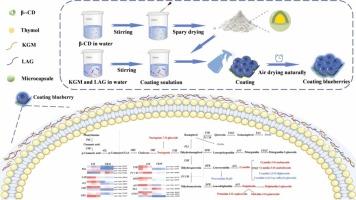Mechanisms underlying the regulation of anthocyanin metabolism in postharvest blueberries by microcapsule-containing thymol coatings
IF 6.8
1区 农林科学
Q1 AGRONOMY
引用次数: 0
Abstract
This study developed a novel microcapsule-containing thymol (THY) coating to stabilize anthocyanin accumulation in postharvest blueberries and to elucidate its underlying regulatory mechanism. The microcapsules were fabricated using β-cyclodextrin (β-CD) modified with polyethylene glycol 6000 (PEG6000) and sucrose fatty acid ester (SE-15). An orthogonal experimental design was employed to optimize the preparation process. The optimized controlled-release coating stabilized THY release while enhancing its antioxidant and antimicrobial properties. Among the coatings with different THY concentrations, the coating containing 30 mg·L⁻¹ THY (CR-30) most effectively preserved blueberry quality and promoted anthocyanin accumulation by regulating the activity of key enzymes related to anthocyanin metabolism. Integrated metabolomic and transcriptomic analyses of the CR-30 treatment identified 20 differentially accumulated metabolites (DAMs), which were enriched in anthocyanin, flavonoid, and related biosynthesis pathways, alongside 21 differentially expressed genes (DEGs) involved in anthocyanin synthesis. Furthermore, key differential transcription factors, including MYB, WRKY, and bHLH, showed significant correlations with the DAMs and DEGs, highlighting their regulatory roles in anthocyanin metabolism. This study elucidates the regulatory mechanisms of THY on anthocyanin metabolism, providing a theoretical foundation for the development of innovative postharvest quality management technologies in blueberries.

百里香酚包被微胶囊调控采后蓝莓花青素代谢的机制
本研究开发了一种新型的含百里酚(thymol)微胶囊包衣,以稳定采后蓝莓花青素的积累,并阐明其潜在的调控机制。采用聚乙二醇6000 (PEG6000)和蔗糖脂肪酸酯(SE-15)修饰的β-环糊精(β-CD)制备微胶囊。采用正交试验设计对其制备工艺进行优化。优化后的控释涂层稳定了THY的释放,同时增强了其抗氧化和抗菌性能。在不同THY浓度的涂层中,含有30 mg·L⁻¹ THY (CR-30)的涂层最有效地保存了蓝莓的品质,并通过调节与花青素代谢相关的关键酶的活性来促进花青素的积累。对CR-30处理的综合代谢组学和转录组学分析发现了20种差异积累代谢物(dam),这些代谢物富含花青素、类黄酮和相关的生物合成途径,以及21种差异表达基因(DEGs)参与花青素合成。此外,包括MYB、WRKY和bHLH在内的关键差异转录因子与dam和deg表现出显著的相关性,突出了它们在花青素代谢中的调节作用。本研究阐明了THY对蓝莓花青素代谢的调控机制,为蓝莓采后品质管理创新技术的开发提供理论基础。
本文章由计算机程序翻译,如有差异,请以英文原文为准。
求助全文
约1分钟内获得全文
求助全文
来源期刊

Postharvest Biology and Technology
农林科学-农艺学
CiteScore
12.00
自引率
11.40%
发文量
309
审稿时长
38 days
期刊介绍:
The journal is devoted exclusively to the publication of original papers, review articles and frontiers articles on biological and technological postharvest research. This includes the areas of postharvest storage, treatments and underpinning mechanisms, quality evaluation, packaging, handling and distribution of fresh horticultural crops including fruit, vegetables, flowers and nuts, but excluding grains, seeds and forages.
Papers reporting novel insights from fundamental and interdisciplinary research will be particularly encouraged. These disciplines include systems biology, bioinformatics, entomology, plant physiology, plant pathology, (bio)chemistry, engineering, modelling, and technologies for nondestructive testing.
Manuscripts on fresh food crops that will be further processed after postharvest storage, or on food processes beyond refrigeration, packaging and minimal processing will not be considered.
 求助内容:
求助内容: 应助结果提醒方式:
应助结果提醒方式:


